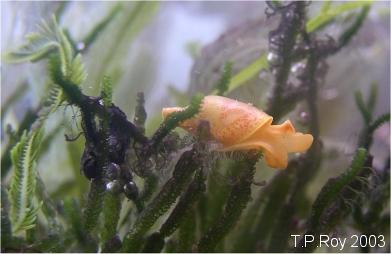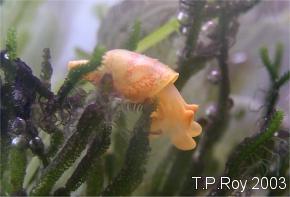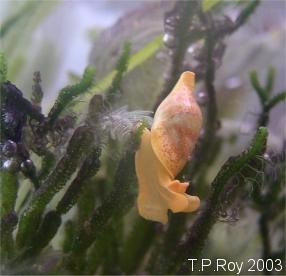Volvatella and young
July 16, 2003
From: Trevor Roy

Hello Dr.
I know little to nothing about Nudibranchia so you can imagine my surprise when a hunk of recently purchased live rock (from Fiji I think) with Caulerpa and some other macroalgae I can't identify, produced a bright orange shelled snail/slug with rhinophores.
From scanning many messages it looks like nudibranchs have a variety of different diets(flatworms, sponges, algae). Any way, I do also have a hermit crab population that seems to have dwindled recently, are they potential food sources? Also I am assuming that if this is a Nudibranch that it is in good health so far since it has budded off two others in the last 3 weeks. They seem to start growing off the back side of the large on and then just drop off as little versions.
Any info you can provide would be greatly appreciated. It seems like a very interesting creature and I want to do my best to keep it healthy and happy, and want to know if there is anything potentially hazardous about it.
Thank you
Trevor Roy
trevor.roy@verizon.net


Dear Trevor,
Your animal is a sea slug but not a nudibranch. It is a species of Volvatella, which is one of a group of herbivorous slugs called sacoglossans. It is one of the more primitive sacoglossans still having a large snail-like external shell. Fortunately it feeds on the Caulerpa you have in your tank so unless you are very attached to the Caulerpa, your sea slugs will be happy as long as they have a supply of that to eat. I can't be certain of the Volvatella species as we don't know enough about variation in these species to be sure.
Concerning the large one budding off two babies. Have a look at my message about dwarf males. Although these animals are hermaphrodite as adults, with a fully functional male and female reproductive system, the male system develops first, and so at quite a small size they are able to act as males while the female system is still developing. Small males are often found on the shells of large animals with whom they mate.
Best wishes,
Bill Rudman
Related messages
-
Volvatella vigourouxi - dwarf males or impetuous youth?
From: Bill Rudman, July 11, 2002 -
Volvatella vigourouxi? from Hachijo Island Japan
From: Shouichi Kato, July 7, 2002 -
Volvatella vigourouxi and possible synonyms
From: Bill Rudman, July 7, 2002
